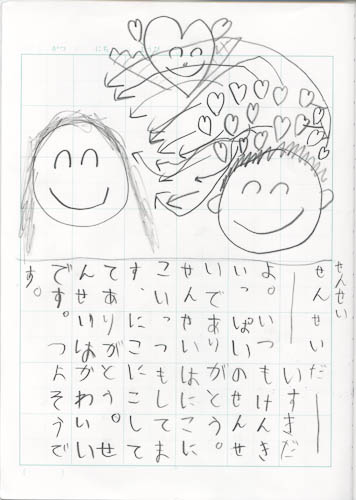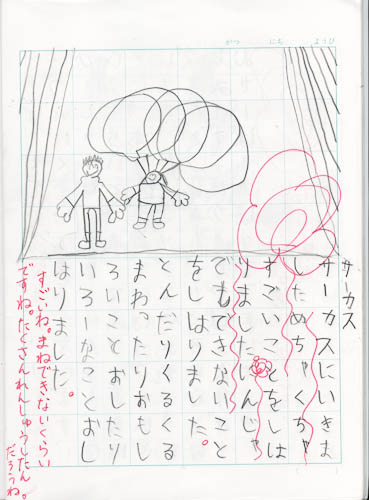One bit of homework Anthony and his first-grade friends have every day is to write an entry in their 絵日記 (enikki — Picture Diary), where they fill half of a page with writing about something from the day, with the other half getting a related picture. I assume its main purpose is for practice in writing Japanese, but it also gives them a chance to stop and think about their day, and good practice for expressing themselves in writing.
Today was the first day back after a long five-day weekend and he couldn't think of something to write, so Fumie asked whether there was any message he might want to say to the teacher, and so he came up with the entry shown above...
Precious.
For his entry yesterday, he wrote about our visit to a Cirque du Soleil show in Osaka on Tuesday, Corteo. I scanned his entrythis evening, after the teacher had made her marks at school today...
It reads...
He had forgotten to punctuate his sentences, so the teacher filled in two periods (though I think four are actually needed). The red squiggles are areas marked with a flower (花丸 hanamaru, “flower circle”), meaning that they're particularly well done. It's equivalent to a gold star or happy-face sticker a kid might get in The States.
The teacher's comments at the end (at left) say “Amazing! One probably couldn't imitate it! They sure must have practiced quite a lot.”
Most of the show was acrobatics and other amazing feats of physical skill (strength, juggling, balance, etc.), but there were episodes of comedy and, like any Cirque du Soleil, episodes of manic LSD-inspired absurdity that no one could possibly understand.
Anthony's pictures refers to one of the scenes of comedy and fun, the “Helium Dance”, where a performer of very slight stature (a midget, a somewhat elderly lady with the most regal poise and grace) is suspended from a bunch of balloons such that she weighs just a touch more than nothing. And so, with a slight push, she can fly through the air in a slow, gentle arc, eventually coming back down at a leisurely pace. The fun part was when she was launched into the audience, who were then told to use both hands to gently pass her along the way, and like a beach ball at a stadium, she went all over. But unlike a beach ball, she's interacting with the audience and having a ball of a time.
I certainly would have liked to fly like that.


I visit your blog daily ~ =)
I love your photos and writings in this blog~! !
THANKS for your hardworking in this blog~ ^^
Just curious, does Cirque in Japan have mostly asian/japanese performers or are they part of the world touring groups with all different races/countries represented?
From what I could tell, there was only one Japanese performer, a guy in a non-acrobatic role of providing occasional Japanese-language explanation (such as to use two hands when dealing with the balloon-floating lady). Most of the other performers seemed to be European judging from their accents. But those that spoke mixed in a lot of Japanese… I was impressed. —Jeffrey